I went to Bogota, Colombia’s capital to visit my cousins Cata and Juanfer, and to meet their families who live in Cajica, a small municipality north of the city. While enjoying an amazing barbeque prepared by Juanfer, I chatted with his wife Vickie who had recently worked for President Uribe and had been in charge of eradicating coca plantations all over the country. As you can imagine she had made a lot of friends and connections everywhere. I asked her about El Choco; which was one of the places that I wanted to see. El Choco is a department in Colombia that is mostly made up of pristine jungle, offering beautiful natural scenery, and tons of wild life. Most tourists that visit Choco go there from July to September to see the migration of the humpback whales. El Choco always sounded very interesting to me; it is what I considered to be a true “off-the-beaten-path” destination that not many foreigners have yet explored. This will quickly change as more Europeans and Americans begin to discover the magic of this region. Seeing the whales near Bahia Solano was out of the question on this trip since I was there in March. I told Vickie that I wanted to experience the “true” Choco. I wanted to stay away from the “backpacker” beaches and head to a more remote area where I could live an authentic experience and interact with some of the local Afro-Colombian communities. Vickie spoke to me about a community with the name of Marriaga where she had spent a lot of time and had fallen in love with the children. She explained that the town was literally on the water and that I would have to take a long boat or “panga” from the city of Turbo in Antioquia to Choco. The trip entailed crossing the Uraba Gulf, and going on the Atrato River before reaching the Cienaga of Marriaga where I would find the small village of the same name. She also warned me that life there was rather primitive and it would feel like a very remote place. Say what?! This was exactly what I was looking for! I immediatelly agreed to travel there as soon as possible. In a matter of 48 hours she had arranged the entire trip for me. She reserved very comfortable accomodations for me in Turbo with one of the local hotel owners, and called the community Leader in Marriaga to ask her to host me overnight and show me around. I ended up finding a cheap flight from Bogota to Monteria from where I would take a four-hour bus to reach Turbo. The Uraba region where Turbo is located is known for its banana plantations. Our bus passed by hundreds and hundreds of banana palms all along the road. Geographically, the bus was barely inside the banana zone but I had already seen the most spectacular display of green. This zone has been known for its violent past where guerrillas and paramilitaries have fought over the cocaine routes out to the Caribbean Sea. But as some locals explained, it has been peaceful for the past ten years in most areas of the region. Luckily Marriaga and other communities in the Atrato Delta have not lived through any violence from the drug war in their recent past. The bus ride to Turbo was nice, hot and humid, and the driver decided to turn off the A/C and asked everyone to open their windows so we could enjoy the natural air. We had a few people come on board the bus at different times selling creams made of herbs including coca and marihuana; which are said to cure different illnesses. They only cost 3,000 pesos (US$1) each. Another man came on board to preach the word of God and spoke for about twenty minutes. I ended up giving him some money. His message was actually quite nice, it was about loving everyone, even our enemies, and living with compassion. Important things to be reminded of once in a while.
When I arrived to Turbo I found the hotel right away and got some rest.
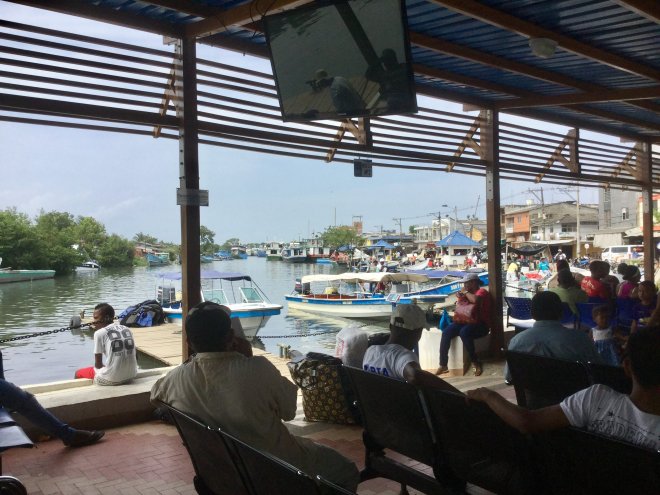
Traveling from Turbo to Marriaga is actually quite easy, you just take the panga with final destination of Tanela and ask the driver to stop in Marriaga. It takes about an hour to get there. We had to make a quick stop at a coast guard post in a bay nearby. The driver parked the panga near the dock and waited while one of the officers went through different passenger bags and asked to check identification cards (cedulas in Spanish). Everyone had to wait patiently and quietly during the security protocol. When the officer was done with the search he came over to where I was and said to me “ma’am, I am afraid you will have to stay with us”, of course this made me very nervous. I looked at him and said “who me?” And he said “yes you, you will have to stay with us”. I asked why and he replied in a very serious manner “because you have beautiful eyes”. I wanted to punch him in the face for making me feel so anxious but at the same time was relieved to know that he was just flirting and I didn’t really have to stay. I couldn’t believe that he would find time to flirt while doing his work, I found this quite annoying. Unfortunately this type of behavior is commonly seen in Colombia. A minute later we were finally on our way to Marriaga. The trip itself is beautiful, lots of birds can be seen flying around in the small hills all along the river and inside the cienagas. We passed the community of Bocas del Atrato; which seemed to be very inviting to tourists with its big restaurant and a nice hotel.
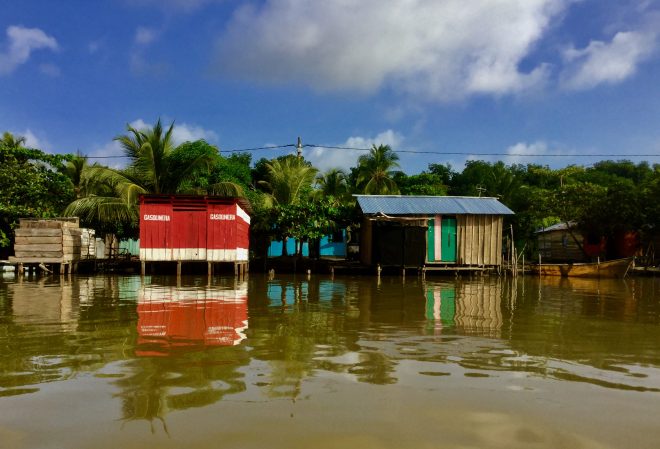
I finally arrived to Marriaga and Francys, the Leader of the community was waiting for me. Not long after my arrival I realized that Francys and other members of the community thought that I had come on behalf of the government. Perhaps they thought that I was Vickie’s representative or that I had taken a similar position in the current administration of President Santos. They were all very eager to talk to me about their projects and show me around the region. They had organized for another panga to take me on a tour of the Cienagas and to one of the neighboring communities- Del Roto. After taking some rest and lunch at Francy’s house, I boarded the panga and headed out on the tour. When we arrived to Del Roto most of the adults where having a townhall meeting and asked me to join. They put me in the center of the room and gathered around. They told me about their concerns of how the fishing had been bad for a long time and that it was imperative that they’d find other sources of income. Yerledys, Marriaga’s school teacher, had come on the panga with me. She explained how some of the women in three communities, Marriaga, Del Roto, and Tumarado had started a knitting/sewing cooperative. They were sewing quite a bit but were unable to take big orders from customers because they did not have the adequate machines to sew faster and fulfill them. They desperately needed to get funds to buy the equipment. It seemed to me that they wanted me to offer the funding. I attentively listened to their explanations and their concerns and later explained that I was there on my own and not with the government. I also expressed my desire to help them obtain the funds for all their projects.
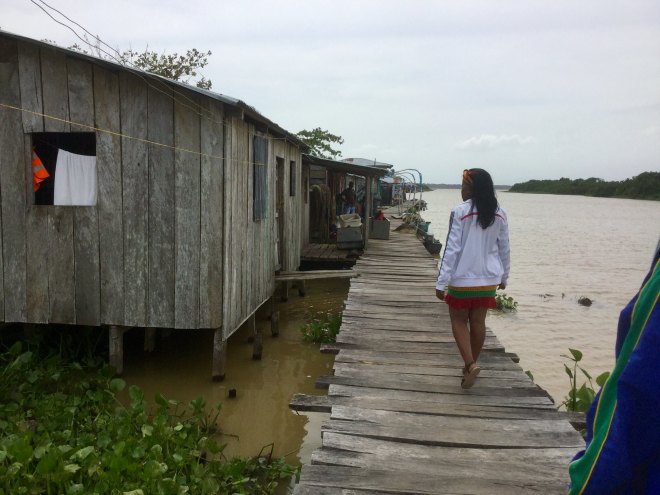


I later had a very similar experience with the members of the Marriaga community. They explained their wishes to begin eco-tourism in their town since fishing was no longer giving them the money they needed to support their families and prosper as a town. One of the elder members explained how the community had been started by people that wanted to fish but now the fish were scarce. They needed to find other ways to make money and they thought that eco-tourism could be the answer. They know how beautiful their region is and how perfect it would be to offer bird-watching as an activity to visitors. I explained that I had been looking for a project in Colombia to get involved with.
Francis explained that they had worked very hard to get funds from the government to build a hotel for future tourists. The hotel looked complete from the outside but they still needed money to build the bridge that would connect it to the town.
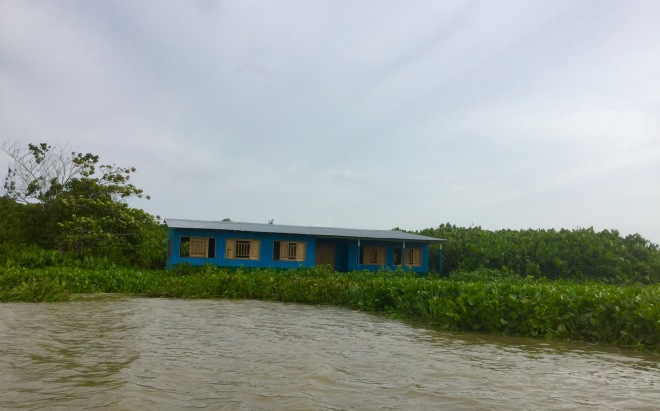
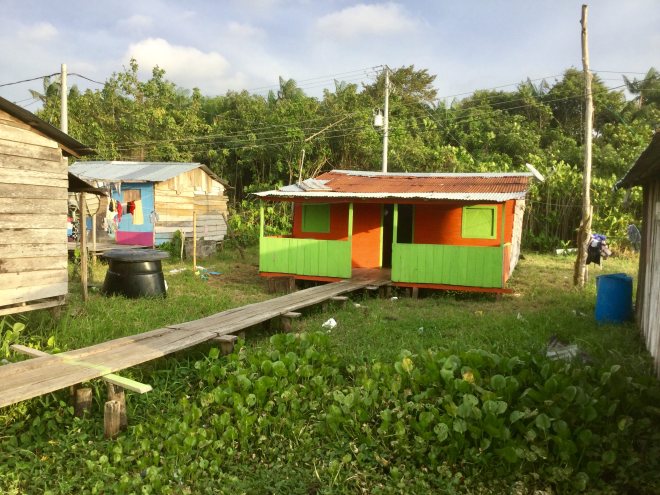
The entire community was made up of wooden houses built on the water standing on stilts and connected to each other by long bridges. They also showed me a playground that Vickie had built for them; which was already falling apart. The children only go to school until 12:00 pm and they have absolutely nothing to do for the rest of the day. The teacher Yerledi had another pending project to build a library where everyone could read, study, play games, etc. I thought that this was probably the most pressing need. I expressed my interest in helping them get the funds necessary to build this library as soon as I returned home.
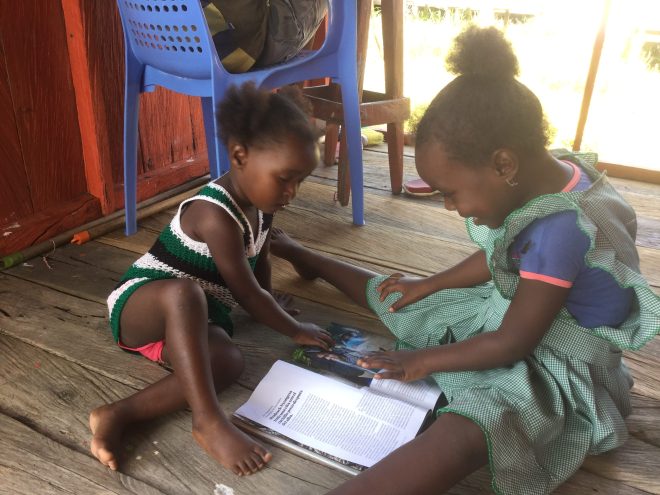
I loved this place so much that I wanted to learn more about it. I ended up staying in Marriaga for three full days. Different members of the community took turns to take me fishing. I experienced beautiful sunrises and sunsets over the water. I saw how Francys and the others worked so hard to catch the fish by setting up the nets across the river. They would usually set up three different nets in various areas and would check them the following day to pull out any trapped fish. They explained that they used to get hundreds of fish in the nets, but nowadays they only get a dozen or so.
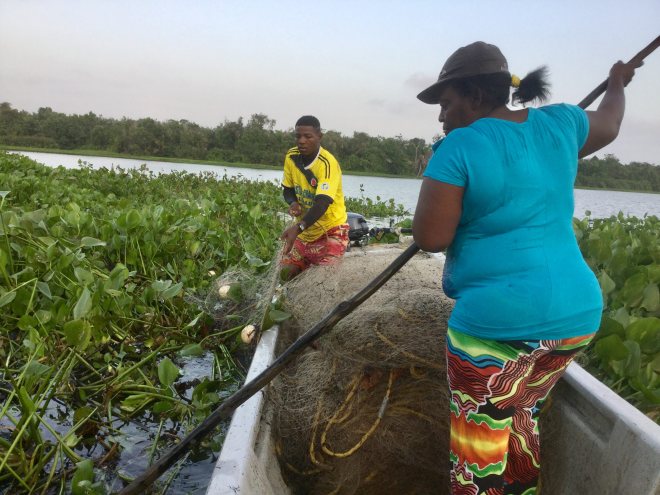
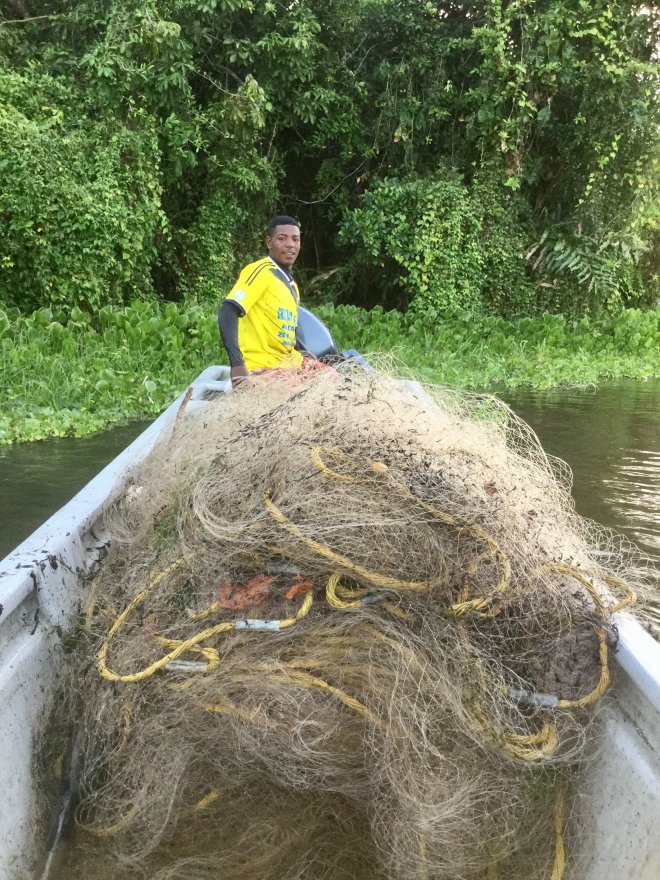 The best part of each trip on the pangas was seeing the wildlife, especially the birds. I got to see ducks, parrots, pelicans, seagulls, vultures, Titi monkeys, and sloths. I also heard the howler monkey families that were deep inside the jungle, howling non-stop during sunrise. The big nets caught many different types of fish like bocachico, robalo, mojarra, barbudo, guacuco, denton, etc. I got to try these with patacones (smashed fried plantains), rice, and salad.
The best part of each trip on the pangas was seeing the wildlife, especially the birds. I got to see ducks, parrots, pelicans, seagulls, vultures, Titi monkeys, and sloths. I also heard the howler monkey families that were deep inside the jungle, howling non-stop during sunrise. The big nets caught many different types of fish like bocachico, robalo, mojarra, barbudo, guacuco, denton, etc. I got to try these with patacones (smashed fried plantains), rice, and salad.
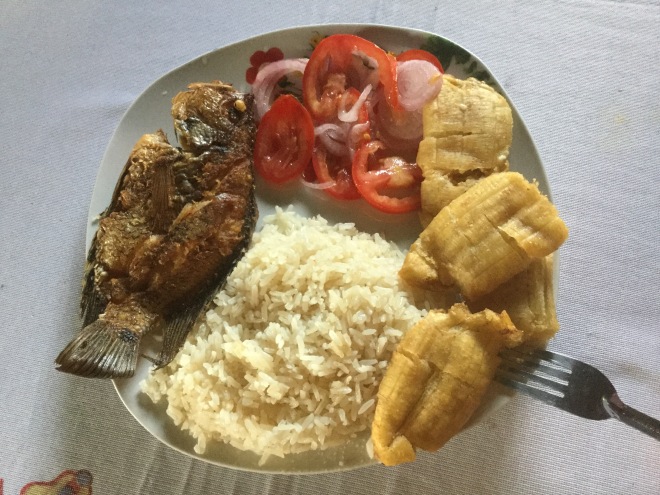 Inside one of the cienagas they had enclosed a square area with netting to build a cage for a fish farm. Everytime they pulled a small fish in the nets, they would mark it to identify who had caught it and then throw it inside the caged area. They would later fish these out when they got larger. One of the most beautiful places was the Cienaga de Limon, an area named as a reserve for the conservation of the Manatee. Unfortunately I didn’t get to see any manatees but I was told that sometimes they can see three or four in the area. I also learned that the best time to come to Marriaga is during the summer when it’s dry and there are no mosquitos. I was there right as the summer was ending but I had no problems at night since they provided a net for my bed. In the winter the rains are abundant. This is in fact one of the rainiest regions in the world so it is a bad idea to visit from May to August.
Inside one of the cienagas they had enclosed a square area with netting to build a cage for a fish farm. Everytime they pulled a small fish in the nets, they would mark it to identify who had caught it and then throw it inside the caged area. They would later fish these out when they got larger. One of the most beautiful places was the Cienaga de Limon, an area named as a reserve for the conservation of the Manatee. Unfortunately I didn’t get to see any manatees but I was told that sometimes they can see three or four in the area. I also learned that the best time to come to Marriaga is during the summer when it’s dry and there are no mosquitos. I was there right as the summer was ending but I had no problems at night since they provided a net for my bed. In the winter the rains are abundant. This is in fact one of the rainiest regions in the world so it is a bad idea to visit from May to August.

The children from the community would come often to Francys’ house to ask for food, especially her cousin’s kids. Francys seemed to have more than others so she was able to help out. She explained that she is very entrepreneurial and always comes up with projects to make extra money. She is very driven and wants to help her community thrive and prosper. Unfortunately not everyone seemed as driven as Francys, but not everyone had had the same opportunities to get an education. It is very common in small towns in Colombia like Marriaga to find people sitting around, drinking all day. Unfortunately this is due to the lack of activities and work in the area, hence another reason to get the funds to build the library and the hotel bridge. They could definitely benefit from some eco-tourism to keep them busy and make money.
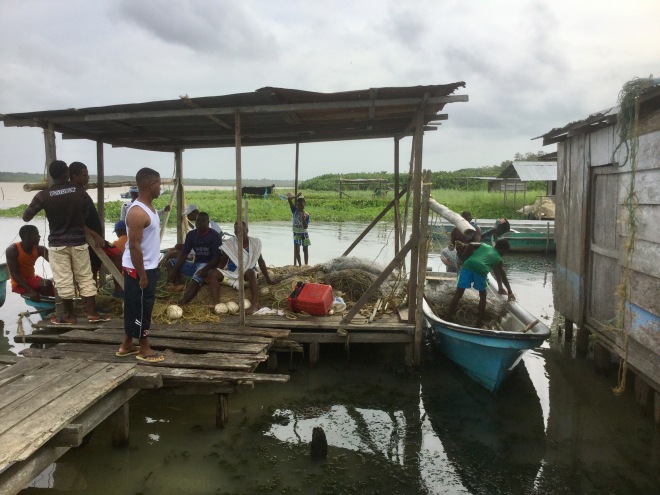
One day while I was having breakfast Bienestar Familiar came over to check on one of the younger kids. This is a governmental organization that helps protect families, especially children, from malnutrition. Yerledys works with them and explained that if a kid is at risk of malnutrition, Bienestar will help them get back to normal by offering them dietary supplements. The workers come from the nearby municipality of Unguia. There are 85 children in the region between the ages of 1 month to 14 years old.
While walking around the town I overheard a conversation between a Bienestar worker and a family about a mentally-challenged woman that had had eight kids so far and was pregnant again at the time. They were examining one of her young kids and they had no idea who the father was. They wanted to get the funds to pay for her surgery so she won’t be able to have any more children. I later learned that her elder (poor) parents will let visitors have sex with her in exchange of money. I also learned that most of these visitors are government workers passing by the area that stop to have a few drinks in the town. It is very sad to hear these stories.

There is definitely not enough to do in this small town. The men go out to fish in the morning and sit around the rest of the afternoon drinking and playing dominoes. The women are busy cleaning, tending to the children, cooking, and washing. The children just run around but their mothers yell at them to stop because some of them don’t know how to swim and they can easily trip on the bridges and fall in the water. A kid had recently drowned. All cleaning is done in the river, the bathing, the washing of fish, the tooth brushing, etc. The currents are strong and they carry away all waste. They try to pick up the trash but sometimes they throw it in the water near the houses and it just collects and rots away there. There is a small fish that they call the “caga” that eats all of the fecal matter so thankfully this is not seen floating in the water. They are building bathrooms with regular toilet bowls and sinks inside the tourist hotel.
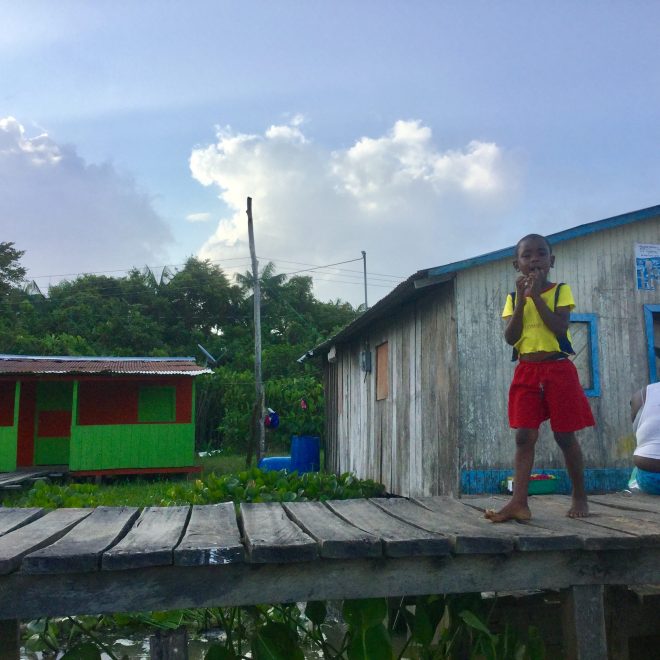
In a matter of 24 hours the kids get very comfortable with me and start calling me “tia” or auntie. They get around me and sing songs. They tell me their names, they sit around me to look at the pictures on my iPad and a Nat Geo magazine that I had brought. They are interested in learning, they are very curious.
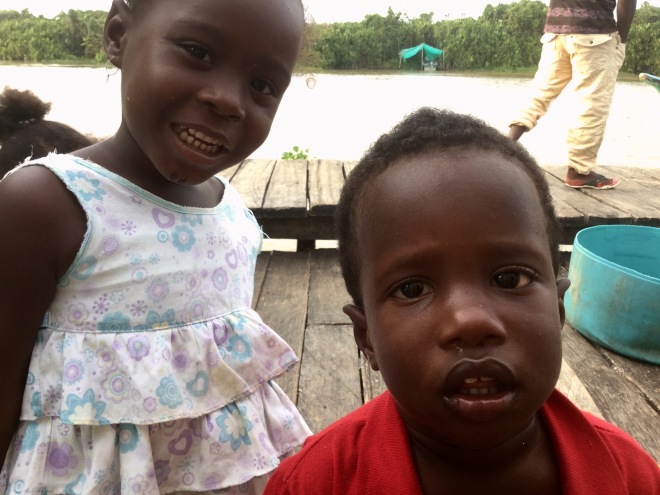 On my second night the children and young teenagers decide to put on a show. They do a well choreographed Mapale dance, a typical Afro-Colombian dance of the Caribbean region. They later follow it with some Reggaeton; which is very popular all over the country. It is saturday night and the Vallenatos, another popular folk Caribbean music, plays loudly late into the night.
On my second night the children and young teenagers decide to put on a show. They do a well choreographed Mapale dance, a typical Afro-Colombian dance of the Caribbean region. They later follow it with some Reggaeton; which is very popular all over the country. It is saturday night and the Vallenatos, another popular folk Caribbean music, plays loudly late into the night.
We go fishing again on the second day. Francys explains that there are only three women that fish in town- herself, Pacha, and Ines, the town’s Pastor. Usually two people go out together on a boat, the fisher and the helper. They end up splitting whatever money they make from the day’s catch. On a very good day they can get anywhere from 50 to 80 fish. They put them in ice and travel in the panga back to Turbo to sell them. If they catch a Robalo it will pay for the entire trip out there. I try to keep my balance to not fall in the water as the boat leans over to the side while they take the netting out. The net is stuck in the “buchones de agua” or floating plants. They work hard to get it out. They move the boat around to push the buchones out of the way. Once they succeed I cheer for them and tell them they are true professionals. Jaider, the helper, points at Francys saying “she taught me”. It is beautiful, calm, and breezy all around. In the area you can find 78 registered species of fish. They had laid out three nets the day before and only one fish comes out of the second net but it is a robalo, the biggest of the day. Jaider explains: “when God blesses us we catch a big robalo or sabalo and can sell it in town and get anywhere from $300 to $1 million pesos”. They sell to pesqueras or fisheries in Turbo, and these in turn sell to restaurants. We ride across the bay, and get ready to pull out the third net. Francys sings and keeps a positive attitude, it is easy to tell why she is the community’s Leader. They catch some “jaivas” or crabs in the net; which they tell me must be killed because they will reproduce and be a hazard as they bite and tear up the nets. They yell to the fish “come out so the tourist can see you”.

On my third day I didn’t want to go fishing in the morning. I actually wanted to do something with the children. I asked them join me on a campaign to clean the community. There was a lot of trash everywhere behind the houses and stuck in the areas between the houses and the bridges. The children were happy to help, it was like a game to them. We had a conversation about the importance of keeping the community clean and not throwing trash in the water, they seemed to understand. We worked hard for a few hours in the worst heat of the day and managed to fill up 20 large bags with trash that we found mostly in the muddy swamps around the houses. Some of us put on mud boots but some children went barefoot. We picked up bottles, all kinds of plastic, some glass, tons of dirty diapers, food wrappers, etc. Out of the adults, Francys was the only one to help. Afterwards I rewarded the children with their favorite potato chips from the local store. Of course they tried to throw the wrappers in the water, out of habit, so I encouraged them to throw it in a trash bag but I had to offer candy in exchange. Two of the adults in town later helped me to create signs and put them on the walls near common areas reminding people to throw the trash in the trash bags. All the bags collected were taken by two teenagers (thanks to Francys) on a panga to the local dump site.
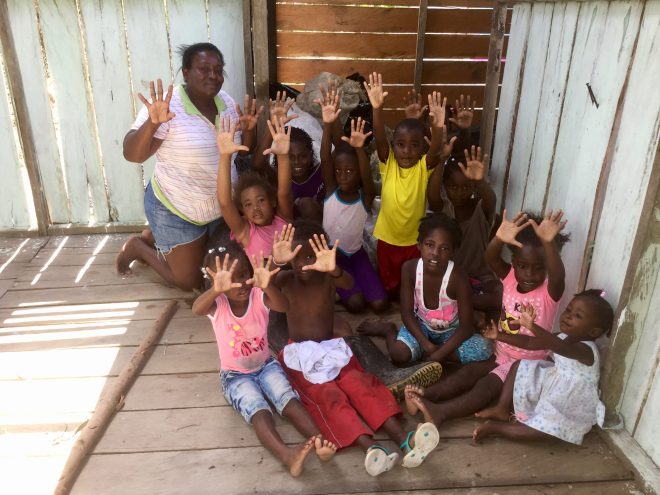
My last afternoon they took me out to Candelaria bay. We went through beautiful mangroves to reach the place where the river meets the Caribbean Sea. We finished the day watching the sunset over the Atrato with a view of the central range in Panama, in the horizon. It was stunning!
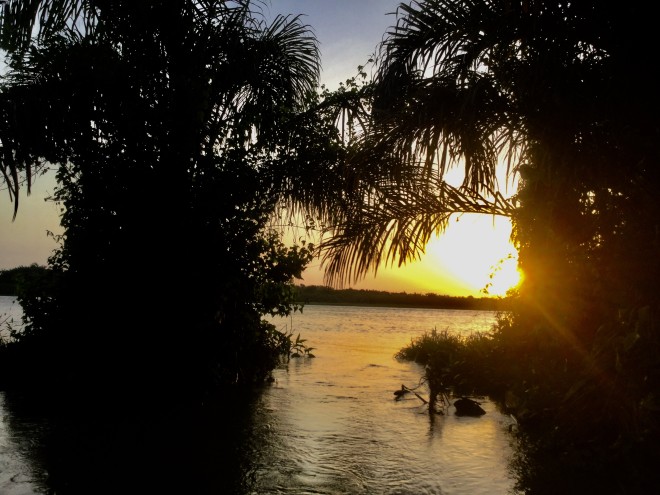 On the fourth day people come out to say goodbye to me as we wait for the panga. They tell me how one of the girls got photographed by a tourist a while back and she is now on a billboard but no one has shared any money with her family. I take a photo of two of the girls who represent well the race diversity of the region. I promise them that if I ever sell the photo, I will bring them the money.
On the fourth day people come out to say goodbye to me as we wait for the panga. They tell me how one of the girls got photographed by a tourist a while back and she is now on a billboard but no one has shared any money with her family. I take a photo of two of the girls who represent well the race diversity of the region. I promise them that if I ever sell the photo, I will bring them the money.

The panga arrived and the kids try to sell their fish to the passengers. All is sold! The Pastor gets on with her granddaughter to send her back to Bogota where the mother is. We travel back to Turbo together. It is nice to have some company.
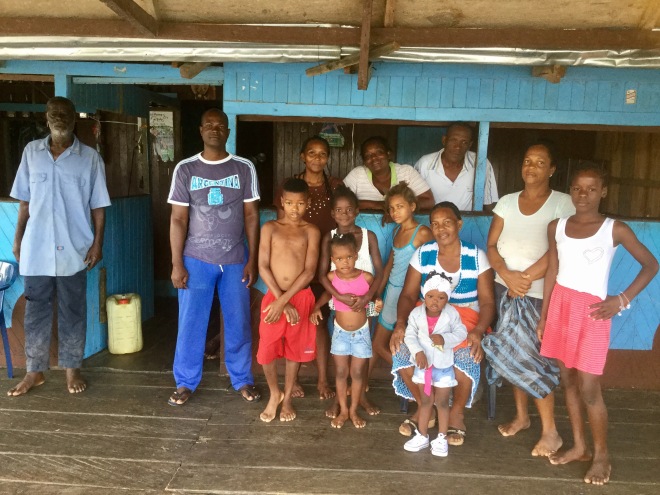
Ecotourists wanted asap in Marriaga!!! Please get in touch with me if you would like to donate to this community’s projects, or arrange a visit to the area. I will be happy to offer you my guiding and translating services. 🙂
